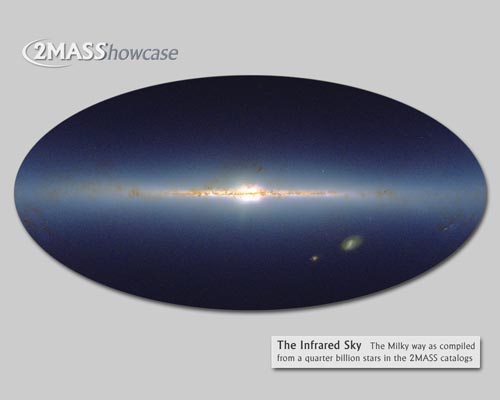|
|
 The Milky Way: a map constructed using infra-red observations by the 2-mm All Sky Survey (2MASS). The bulge and disc can be clearly seen, as can the Large and Small Magellanic Clouds at the bottom right. The form of the Galaxy is easier to see in infra-red light, because this is not blocked by the dust in the Galactic plane. This image was obtained as part of the Two Micron All Sky Survey (2MASS), a joint project of the University of Massachusetts and the Infrared Processing and Analysis Center/California Institute of Technology, funded by NASA and the NSF. Image credit: J. Carpenter, M. Skrutskie, R. Hurt.
The Milky Way: a map constructed using infra-red observations by the 2-mm All Sky Survey (2MASS). The bulge and disc can be clearly seen, as can the Large and Small Magellanic Clouds at the bottom right. The form of the Galaxy is easier to see in infra-red light, because this is not blocked by the dust in the Galactic plane. This image was obtained as part of the Two Micron All Sky Survey (2MASS), a joint project of the University of Massachusetts and the Infrared Processing and Analysis Center/California Institute of Technology, funded by NASA and the NSF. Image credit: J. Carpenter, M. Skrutskie, R. Hurt.
|
Summary of Lecture 7 – The Milky Way
- The Milky Way appears to the naked eye as a band of light across the dark night sky:
- telescopes resolve it into faint stars;
- its appearance can be explained by assuming that we are inside a large disc-shaped assemblage of stars: we see more stars looking in the disc than looking out of it;
- dark streaks and breaks in the band are opaque dust, not really areas without stars.
- The distribution of globular clusters peaks around 25000 light years from the Sun:
- distances determined by comparing position of horizontal branch in their HR diagrams with calibrated HR diagrams;
- centre of distribution is centre of Milky Way;
- globular clusters are found far from Milky Way in the sky → unlike unclustered "field" stars, not concentrated in disc.
- Open clusters and hydrogen gas (detected by its radio spectral line at 21 cm) are very concentrated along the plane of the Milky Way:
- they are part of the disc;
- because stars form from gas, star formation must be confined to the disc.
- The Milky Way is gravitationally bound, so the stars and gas all orbit the centre:
- the Sun orbits at about 200 km/s;
- other nearby stars move slowly relative to the Sun (~20 km/s) –
- they must be on orbits very similar to the Sun's;
- the disc of the Milky Way rotates in a coherent fashion;
- as the motion is mostly sideways (not towards or away from the centre), the orbits are fairly circular;
- globular clusters and some old stars low in heavy elements move fast relative to the Sun (~200 km/s), and in random directions –
- their orbits are very different from the Sun's;
- the halo of the Milky Way does not rotate like the disc;
- as they move towards and away from the centre as well as sideways, halo orbits are elliptical rather than near-circular.
- Hydrogen gas maps out spiral arms in the disc:
- the Milky Way is a spiral system;
- nearby portions of spiral arms can be mapped out in young, massive stars – the spiral arm stars are younger than the rest of the disc.
- Therefore we can identify three distinct stellar populations:
- the very young spiral arm population (rotating system, circular orbits, stars high in heavy elements);
- the rest of the disc, including the Sun (rotating system, near-circular orbits, wide age range, stars generally fairly high in heavy elements);
- the halo, including the globular clusters (non-rotating system, randomly oriented elliptical orbits, old stars, low in heavy elements).
- In infra-red light we can see through the dust (see image above):
- reveals a central bulge;
- fourth population (slowly rotating system, though with elliptical orbits, old stars, but moderately high in heavy elements)
- By looking at the orbital speed of stars and gas and applying Newton's laws, we can measure the mass of the Milky Way:
- in the outer regions (where the Sun is), this is much greater than we would expect from the stars we see;
- most of the Galaxy's mass appears to be invisible dark matter.
- The central nucleus of the Galaxy is different from the rest of the bulge:
- radio observations show gas and young supernova remnants (evidence of recent star formation);
- exact centre is a radio and X-ray source;
- infra-red observations show young, massive stars rapidly orbiting a central mass of ~4.1 million solar masses;
- this appears to be a supermassive black hole (as also observed in other galaxies).
Web links
- The PowerPoint file for this lecture.
- There is a brief introduction to the Milky Way, mainly aimed at amateur astronomers, on the SEDS Messier site. Nick Strobel has a chapter on the Milky Way, including this useful summary; Gene Smith has a Milky Way page too.
- Images of the Milky Way at many wavelengths can be found here.
- The Max Planck Institute at Garching has done some of the studies which lead us to believe in the existence of a central supermassive black hole; their website includes some nice animations showing the motion of the stars around the centre and the effect of atmospheric turbulence.
- A short self test for this lecture.
Go back to main page
Go on to Summary for Lecture 8
|
Hicks Building, Hounsfield Road, Sheffield S3 7RH, UK
|